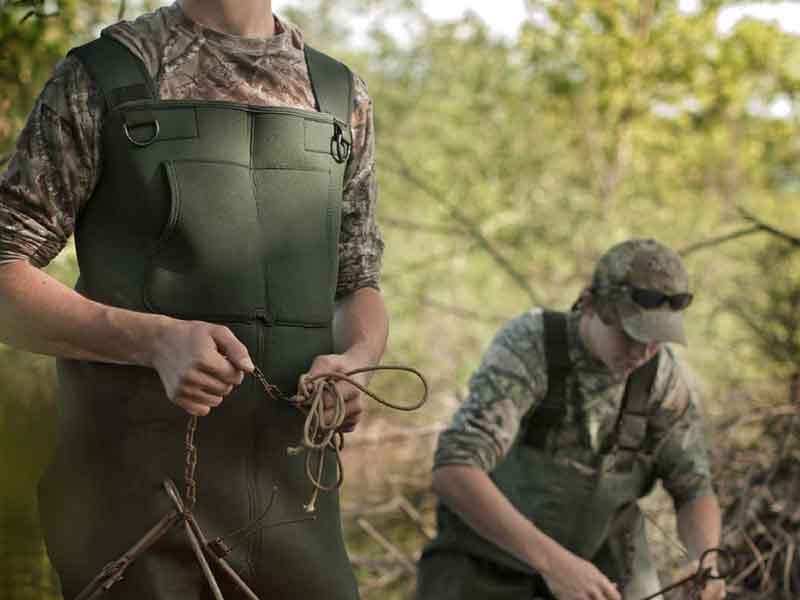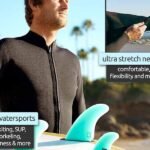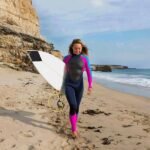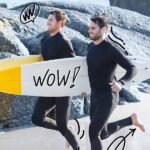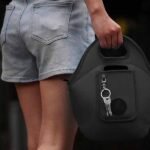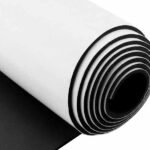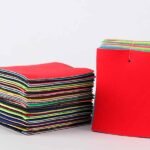For anglers, hunters, and outdoor adventurers, waders are more than gear—they’re the difference between comfort and misery in cold, wet environments. Among the many options, neoprene waders stand out as some of the best for insulation, durability, and all-weather performance. Unlike breathable waders, which excel in warmer conditions, neoprene waders shine in icy rivers, marshlands, and coastal waters where warmth is a top priority.
Neoprene waders are waterproof overalls made from thick neoprene material that insulates against cold water while keeping wearers dry. The best neoprene waders come in chest, waist, or hip styles, with bootfoot or stockingfoot options. They are warmer and more durable than breathable alternatives, making them ideal for fishing, duck hunting, and outdoor activities in cold environments. Thickness ranges from 3mm to 7mm, with added reinforcements for rugged use.
Now picture this: it’s late November, and you’re fly-fishing in an icy river. Without proper waders, your feet and legs would quickly go numb. With neoprene waders, however, you stay insulated, dry, and focused on the catch. This combination of comfort, safety, and performance is what makes neoprene one of the most reliable wader materials on the market. In this guide, we’ll explore the 10 best neoprene wader types, what makes them unique, and how to choose the right pair for your needs.
What Are Neoprene Waders and Why Are They Among the Best for Cold Water?
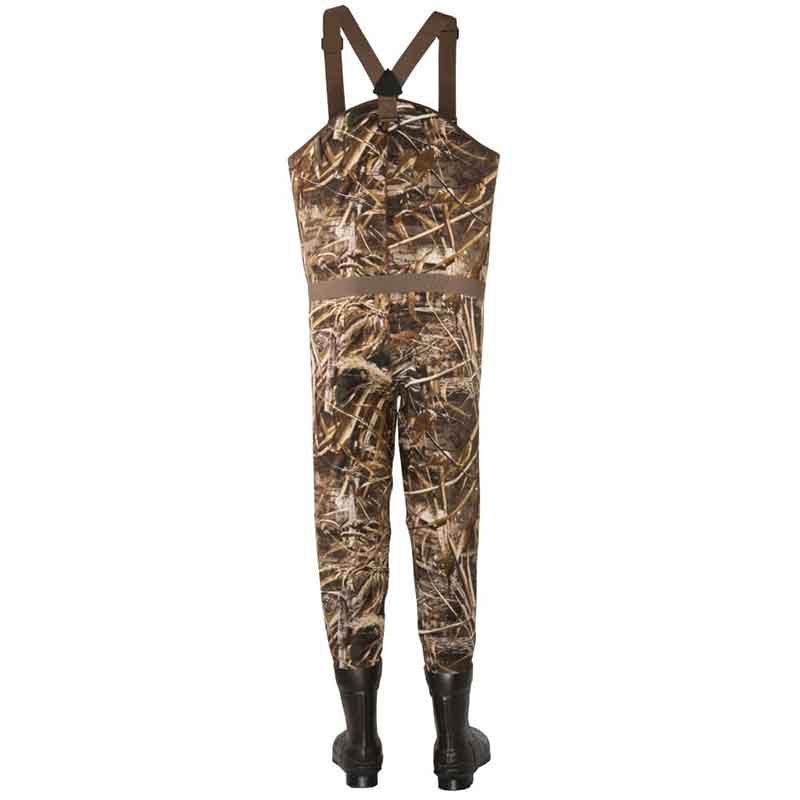
Neoprene waders are waterproof overalls made of insulating neoprene rubber, designed to keep anglers and hunters warm and dry in cold water. They outperform breathable waders in insulation and are considered the best choice for freezing conditions.
Neoprene is a synthetic rubber best known for wetsuits, diving gear, and thermal protective clothing. When applied to waders, it creates a sealed, waterproof barrier that traps body heat.
Why Neoprene Excels in Cold Water
- Insulation Value: Neoprene contains tiny air bubbles that trap heat. A 5mm neoprene wader provides warmth equivalent to several thermal clothing layers.
- Waterproofing: Unlike breathable nylon or Gore-Tex, neoprene is completely impermeable to water.
- Durability: It resists punctures better than thin breathable materials, making it more rugged for hunting in marshes or fishing in brushy rivers.
Comparison with Breathable Waders
| Feature | Neoprene Waders | Breathable Waders |
|---|---|---|
| Insulation | Excellent (3–7mm) | Poor (requires layers) |
| Waterproof | 100% impermeable | Breathable but less insulating |
| Durability | High (abrasion resistant) | Moderate (tear-prone) |
| Comfort | Heavy, less flexible | Lightweight, comfortable |
Critical View:
While neoprene excels in cold weather, it is less breathable, which can cause overheating in summer. For this reason, many outdoorsmen own two sets of waders—neoprene for winter and breathable for spring/summer. But for cold-water fishing, duck hunting, or winter work, neoprene remains one of the best options available.
Which Are the Best Types of Neoprene Waders?
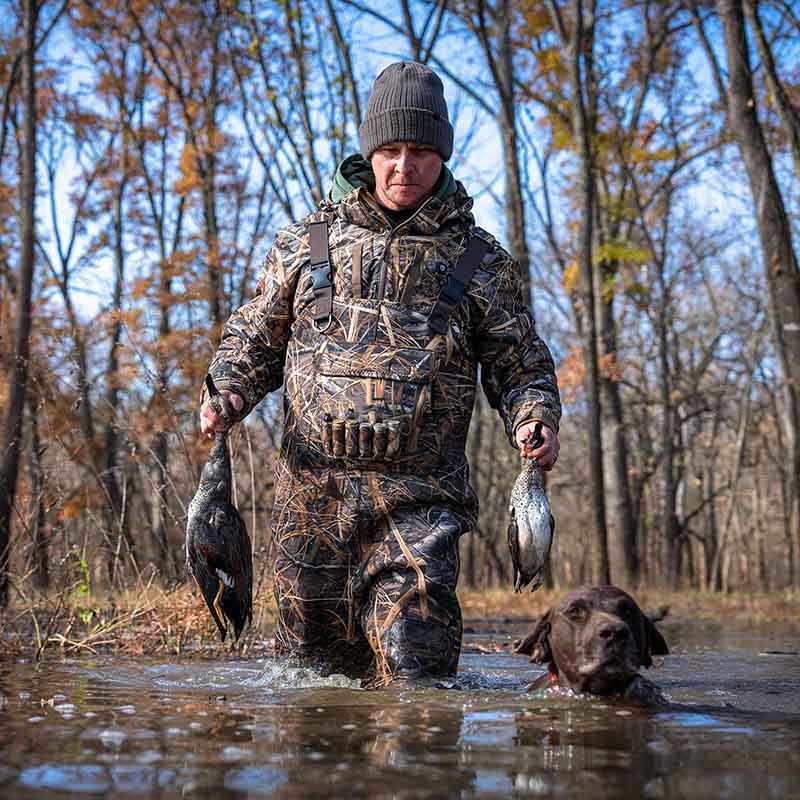
The best types of neoprene waders include chest, waist, and hip designs, each available in bootfoot or stockingfoot versions. Chest waders offer maximum coverage for deep waters, waist waders balance mobility and warmth, while hip waders suit shallow streams. Thickness options (3mm, 5mm, 7mm) determine insulation. The “best” depends on your activity: chest bootfoot for cold-water duck hunting, waist waders for river fishing, or hip waders for lightweight, casual use.
Dive Deeper: The 10 Best Neoprene Wader Types in Detail
When buyers search for the best neoprene waders, they aren’t just looking for “a pair of waders.” They want the right style, insulation, and fit for their specific environment. Below are the 10 most important types, with pros, cons, and best applications:
1. Chest Bootfoot Neoprene Waders (5mm Standard)
- Best for: Cold rivers, deep water fishing, duck hunting.
- Pros: Complete coverage, built-in boots, easy to wear.
- Cons: Heavier, less flexible, limited boot options.
- Why Best: The most common and versatile neoprene wader, ideal for freezing water.
2. Chest Stockingfoot Neoprene Waders (5mm)
- Best for: Fly fishing, anglers who prefer custom wading boots.
- Pros: More flexibility, replaceable boots, better traction with studded soles.
- Cons: Requires separate boots, slightly less convenient.
- Why Best: Offers versatility and performance for serious anglers.
3. Waist Bootfoot Neoprene Waders (3mm–5mm)
- Best for: Shallow rivers, moderate climates, long walks.
- Pros: Lightweight, easier to move in, built-in boots.
- Cons: Limited depth coverage.
- Why Best: Perfect for anglers who don’t need chest-high coverage.
4. Waist Stockingfoot Neoprene Waders
- Best for: River fishing, mobility-focused activities.
- Pros: Comfortable for hiking, pairable with quality boots.
- Cons: Not suitable for deep water.
- Why Best: Great balance between insulation and freedom of movement.
5. Hip Bootfoot Neoprene Waders (3mm)
- Best for: Shallow streams, warm weather fishing.
- Pros: Lightest and easiest to wear, slip-on convenience.
- Cons: Limited protection, only thigh-high.
- Why Best: Ideal for quick fishing trips or shallow creeks.
6. Hip Stockingfoot Neoprene Waders
- Best for: Hunting or fishing requiring long walks in shallow waters.
- Pros: Lightweight, better fit with custom boots.
- Cons: Very limited water coverage.
- Why Best: Popular for upland hunters who cross small creeks.
7. 7mm Chest Bootfoot Neoprene Waders (Extreme Cold)
- Best for: Ice fishing, Arctic rivers, or mid-winter duck hunting.
- Pros: Maximum insulation, extremely warm.
- Cons: Very heavy, less mobility, expensive.
- Why Best: The ultimate wader for sub-zero conditions.
8. Reinforced Knee/Seat Neoprene Waders
- Best for: Rugged terrain, rocky rivers, swamp hunting.
- Pros: Extra durability, puncture-resistant panels.
- Cons: Heavier than standard models.
- Why Best: Lasts longer in abusive conditions, ideal for hunters.
9. Convertible Chest-to-Waist Neoprene Waders
- Best for: All-season use.
- Pros: Adjustable straps convert them to waist height, more versatile.
- Cons: Bulkier than dedicated waist waders.
- Why Best: Flexible choice for buyers who want one wader for multiple environments.
10. Women’s Fit Neoprene Waders
- Best for: Female anglers and hunters.
- Pros: Anatomical fit, lighter weight, better comfort.
- Cons: Fewer options available, sometimes pricier.
- Why Best: Provides comfort and mobility often missing in unisex designs.
Comparison Table: Choosing the Best Neoprene Wader Type
| Type | Coverage | Best Thickness | Ideal Use | Pros | Cons |
|---|---|---|---|---|---|
| Chest Bootfoot | Full body | 5mm | Cold rivers, duck hunting | Easy, durable, full coverage | Heavy, limited boots |
| Chest Stockingfoot | Full body | 5mm | Fly fishing, deep rivers | Replaceable boots, flexible | Needs boots separately |
| Waist Bootfoot | Waist-high | 3–5mm | Shallow rivers, walking | Lightweight, easy to wear | Less coverage |
| Waist Stockingfoot | Waist-high | 3–5mm | Active anglers, mild weather | Flexible, pair with boots | Not for deep water |
| Hip Bootfoot | Thigh-high | 3mm | Streams, creeks, warm climates | Easiest to slip on | Very limited coverage |
| Hip Stockingfoot | Thigh-high | 3mm | Upland hunting, stream crossing | Comfortable for walking | Shallow use only |
| 7mm Chest Bootfoot | Full body | 7mm | Ice fishing, winter hunting | Warmest, extreme insulation | Heavy, expensive |
| Reinforced Knee/Seat | Full body | 5–7mm | Rugged terrain, rocky areas | Extra durable, long-lasting | Less flexible |
| Convertible Chest-to-Waist | Adjustable | 5mm | Multi-season fishing | Versatile, dual use | Bulkier than singles |
| Women’s Neoprene Waders | Varies | 3–5mm | Female anglers, comfort fit | Better fit, lighter | Fewer models available |
Critical View
The term “best” is subjective—it depends on activity, climate, and buyer goals. For example:
- A duck hunter in Minnesota will say 7mm chest bootfoot waders are the best.
- A summer angler in shallow streams may prefer hip bootfoot.
- A professional fishing guide will likely choose chest stockingfoot for flexibility.
This is why many professionals own more than one pair of waders, just as they own different rods for different fishing styles.
How to Choose the Best Neoprene Waders for Fishing or Hunting?
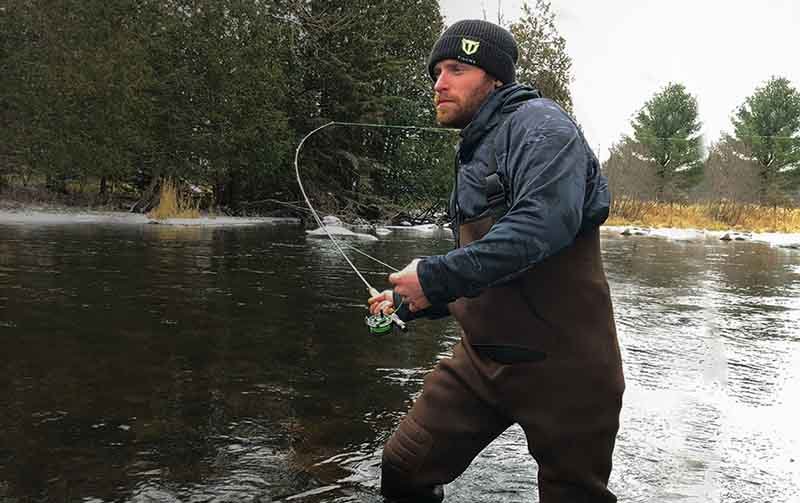
To choose the best neoprene waders, consider water depth, season, and activity. Chest waders suit deep rivers, waist waders offer mobility, and hip waders fit shallow waters. Thickness (3mm–7mm) and features like reinforced knees should match conditions.
Choosing neoprene waders isn’t just about style—it’s about matching your gear to your environment.
Fishing Needs:
- Fly fishing in rivers → Chest stockingfoot waders (5mm).
- Surf fishing → Chest bootfoot (5–7mm).
- Shallow stream angling → Waist waders (3mm).
Hunting Needs:
- Duck hunting in icy marshes → Reinforced 7mm bootfoot chest waders.
- Upland hunting with occasional stream crossing → Waist waders (5mm).
Seasonal Use:
- Spring/fall → 3mm waist or hip waders.
- Winter → 5–7mm chest waders.
Buyer Considerations
- Mobility vs Warmth: Waist waders = lighter, but less coverage. Chest waders = full coverage, but heavier.
- Budget vs Performance: Premium waders ($200–300) last longer, but affordable OEM/OEM options from factories like Szoneier can deliver comparable durability with customization.
Critical View:
The wrong choice leads to discomfort. A hunter using 3mm waders in freezing conditions risks hypothermia, while an angler in 7mm waders in warm weather will overheat. The best neoprene wader is the one that matches your specific scenario.
Are Neoprene Waders the Best for Warmth and Durability Compared to Other Materials?
Yes. Neoprene waders are the best for warmth and durability in cold environments, outperforming breathable fabrics. While heavier and less comfortable in warm weather, they provide superior insulation, abrasion resistance, and longevity under rugged conditions.
- Warmth: Neoprene retains heat exceptionally well. Breathable waders require multiple layers underneath.
- Durability: Neoprene resists brush, rocks, and thorns better than nylon.
- Trade-offs: Heavier weight and lack of breathability make them less ideal for summer.
| Material | Warmth | Durability | Breathability | Weight |
|---|---|---|---|---|
| Neoprene | Excellent | Excellent | Poor | Heavy |
| Nylon | Fair | Moderate | Good | Light |
| Gore-Tex | Fair | Moderate | Excellent | Light |
Critical View:
For cold, rugged conditions, neoprene is best. But many professionals own both neoprene and breathable waders to cover all seasons.
What Features Define the Best Quality Neoprene Waders?
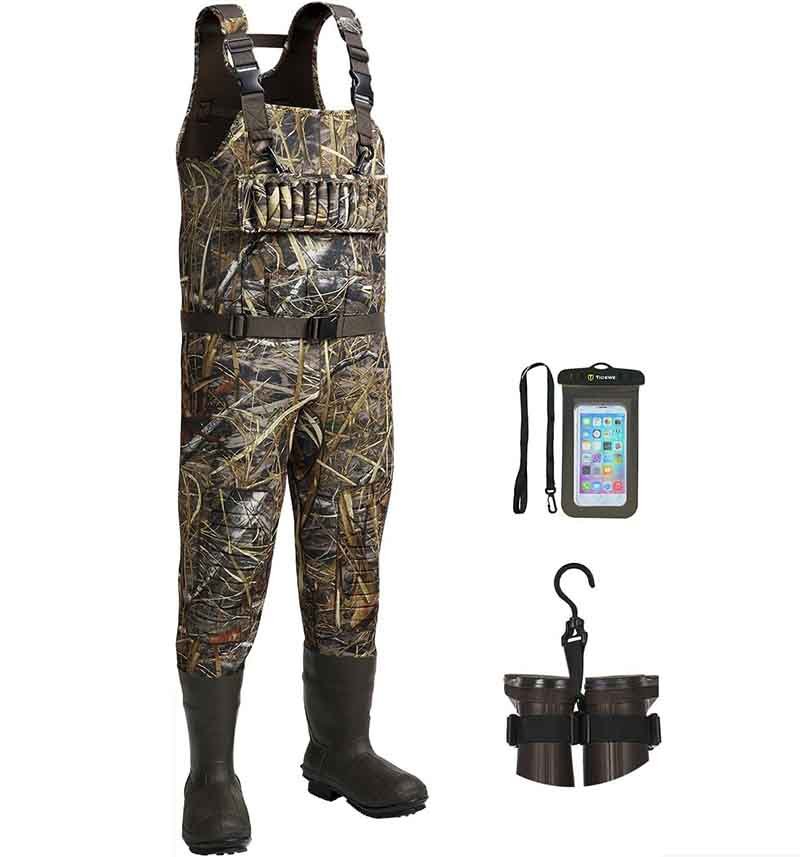
The best neoprene waders feature reinforced knees, taped seams, adjustable suspenders, storage pockets, and either bootfoot or stockingfoot design. Thickness, fit, and durability features define quality.
- Reinforcements: Knees and seat areas should be double-layered.
- Seam Construction: Stitched + taped or glued for leak prevention.
- Adjustable Fit: Suspenders, belts, and anatomical design for comfort.
- Practical Features: Waterproof chest pockets, hand-warmer pouches, and gravel guards.
Critical View:
Many “cheap” waders skip reinforcements or use single-stitched seams. For OEM buyers, ensuring reinforced stress points is critical for customer satisfaction and fewer product returns.
Do the Best Neoprene Waders Require Special Care and Maintenance?
Yes. Neoprene waders require regular cleaning, air drying, and proper storage. Avoid folding tightly or exposing to UV heat for long periods. With care, neoprene waders can last 5–10 years.
Deep Dive:
- Cleaning: Rinse with freshwater after each use. Mild soap for dirt.
- Drying: Air dry inside-out, then outside. Avoid direct sunlight.
- Storage: Hang by straps, not folded. Store in cool, dry place.
- Repairs: Small punctures can be patched with neoprene cement.
Critical View:
Customer education is crucial—many returns happen due to poor maintenance, not defects. OEM sellers should include care instructions to extend product life.
Which Brands Offer the Best Neoprene Waders, and Can You Customize Them?
Top neoprene wader brands include Cabela’s, Simms, Frogg Toggs, and Hodgman. OEM/ODM factories like Szoneier provide customization options—logos, sizing, reinforcements, and private label production—for buyers seeking wholesale solutions.
- Global Leaders: Cabela’s and Simms dominate premium markets. Frogg Toggs offers budget-friendly lines.
- OEM/ODM Options: Factories like Szoneier deliver customized neoprene waders with private labeling, low MOQ, and fast prototyping.
- Customization Benefits:
- Logo branding for resellers.
- Tailored thickness and reinforcements for niche markets.
- Gender-specific sizing.
Critical View:
Big-name brands dominate retail, but OEM solutions allow smaller companies to compete with custom designs at lower costs.
Conclusion: Why Source Neoprene Waders from Szoneier?
Neoprene waders remain the best choice for cold-weather fishing, hunting, and outdoor adventures. With multiple types—chest, waist, hip, bootfoot, stockingfoot, 3mm to 7mm—there’s no single “best,” only the one that fits your needs.
At Szoneier, with over 18 years of neoprene manufacturing expertise, we specialize in:
- 100% quality assurance with reinforced, tested waders.
- OEM/ODM customization for logos, colors, thickness, and sizing.
- Free samples, low MOQ, and fast turnaround.
- Supplying global buyers from small resellers to high-end brands.
📩 Ready to source the best neoprene waders for your market?
👉 Contact Szoneier today at:
📞 +86 13423847456

